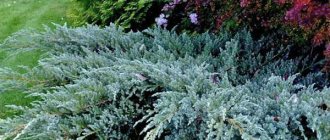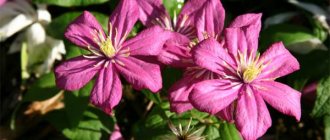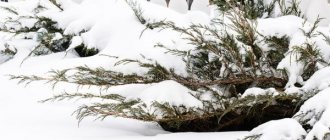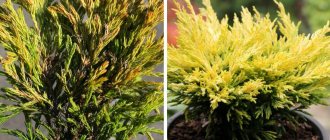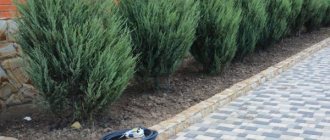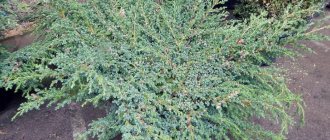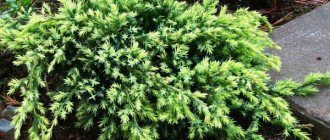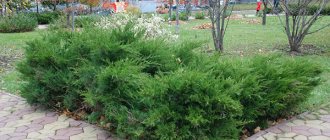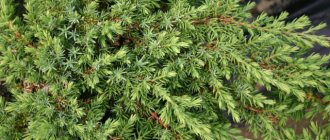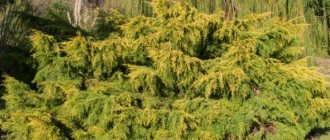Horizontal
The second name for this type of juniper is prostrate, since its representatives are distinguished by a creeping crown, which allows them to be used as ground covers. It is formed from long creeping branches with a large number of short vegetative shoots. Popular blue varieties in this group include:
- Ice Blue. One of the shortest (10-15 cm) junipers with a rapid growth rate: in just a few years it grows up to 2 m wide. Flexible shoots pressed to the ground can form a dense blue carpet, flow around obstacles and fall from hills. Soft needles change color to purple in the cold season. The plant is resistant to drought and frost; if planted on heavy soils, it requires drainage.
- Blue Forest. Horizontal juniper up to 50 cm high with an annual growth of about 10-15 cm. A dense crown, spreading up to 1.5 m, is formed from densely arranged flexible short shoots. The small needles have a scaly structure and a silver-blue color, but by winter they turn purple. The spherical blue-black coneberries grow up to 5-6 mm. Representatives of the variety can be planted even in light shade, the main thing is to monitor the average level of humidity and provide loamy or sandy loam soil.
- Blue Chip. Shrubs growing up to 30 cm are distinguished by a creeping star-shaped crown up to 2 m in diameter. They are characterized by a sparse horizontal arrangement of the main shoots with a large number of lateral branches growing upward. Very small blue needles may have a needle-like or scaly structure. The variety adapts well to climatic conditions, easily tolerates frost, drought, and air pollution, but for successful cultivation, sunlight and well-drained soil are important, since plants cannot tolerate waterlogging.
- Wiltoni. Creeping dwarf juniper grows no higher than 20 cm and grows up to 2 m in diameter with an annual growth of up to 10 cm. Its diversified shoots intertwine with each other and form a dense gray-blue carpet, which turns slightly yellow in winter. The variety is drought- and frost-resistant, unpretentious to soil composition, and is suitable for landscaping rocky hills, slopes or growing in containers.
Popular varieties of blue junipers
Of course, many gardeners ask questions about why blue junipers are so popular, and in this article we will answer this question. The thing is that blue needles really look very attractive and unusual when it comes to the design of landscapes, garden plots, and flower beds. There are several more reasons for this popularity:
- blue junipers look very original; they can become an original decoration for absolutely any landscape composition if you add some other crops. In addition, juniper is a very standard plant, since when decorating a flowerbed in absolutely any form, you can fit juniper into it; it will not make it worse, but will only decorate it. The high decorative quality of blue junipers is precisely what sets them apart from other plant varieties - juniper easily retains its decorative qualities throughout the year. In a snowy flowerbed, the plant looks no worse than in a summer flowering flowerbed. At the same time, in the fall, some junipers can change their color to brown, which makes them even more attractive and unusual - blue junipers are bushes that can be used in a variety of applications. In garden design, blue junipers are frequent guests, and they can also be found in garden plots, in the design of park areas and public places. Sometimes such junipers are simply displayed to decorate an apartment, which also looks very unusual and decorative.
All this makes blue junipers incredibly versatile. Of course, this is a huge advantage over many other cultures. The bushes look great when decorating slopes, for creating hedges, or for organizing solitary plantings just on the lawn.
Also, blue junipers are frequent and, most importantly, welcome guests in decorating rock gardens and rockeries; they can be grown near artificial ponds and not at all be afraid that the root system will feel uncomfortable. There are several of the most sought after and popular varieties of blue juniper, which today grow in various regions of our country.
Juniper Kazatsky and its varieties
Juniper Cossack is a juniper that has a very attractive blue crown. At the same time, this variety is one of the most popular among any other varieties of blue junipers. It includes more than twenty known species, and the best of them are: - tamariscifolia - rockery jam - cupressifolia - blue danub These varieties are the most famous and attractive, as they are very easy to care for and produce very beautiful juniper bushes that amaze the imagination. Tamariscifolia is a bush that reaches a height of about one meter, but the diameter of the crown is almost twice the height of the tree - it varies from 180 to 200 centimeters. The branches are not located straight, but at an angle of 40 degrees. The coniferous crown is distinguished by the fact that it is very prickly, blue, some needles have a slight silvery color. The shrub as a whole can have an interesting shiny hue at any time of the year, as if the needles were covered with frost. This bush looks great on rocky surfaces, and can also be placed in rockeries where light-colored stones will be located.
Rockery jam is a small, almost dwarf juniper bush that reaches no more than half a meter in height. At the same time, its crown is very wide, spreading, and can reach about five meters. The plant is creeping and looks great instead of lawn grass - very neat and, at the same time, very decorative. The needles have a blue-turquoise tint, which cannot but please the eye of a gardener or landscape designer.
Cupressifolia is also a variety of juniper that belongs to dwarf crops. The height of the bush is no more than sixty centimeters. But at the same time, it is not as spreading as the bush of the previous variety, Rockery Jam, is. The crown is generally very compact. Its diameter does not exceed 2-2.5 meters. The needles have a bluish-green tint and may have a slight blue tint, which makes the bush even more attractive. The variety is usually grown in specialized rock gardens, as well as for decorating artificial reservoirs. In general, the plant is really very compact, neat, and quite easy to care for, like other varieties of blue juniper, but we will talk about this a little later.
Blue Danube is an evergreen juniper bush that has a very lush crown. The height of the bush reaches sixty centimeters, the diameter of the crown is about three meters, no more. The branches at the ends are slightly raised and have a gray-blue color, like the needles. You can also notice a slightly bluish coating on the needles; the plant looks very decorative. The berries that form on juniper bushes have the same bluish bloom. The length of the berries can reach more than one centimeter; they ripen regularly, every year. It is worth remembering that the berries of this juniper are poisonous, so you need to be careful when collecting them or generally when interacting with the berries. This bush is a creeping species and can withstand even the most severe frosts. As practice shows, the bush does not need to be covered even when the temperature drops to -40 degrees.
Ideally, this variety can be grown in sunny areas. It can be an excellent backdrop for decorating various types of flower beds, as well as for creating a backdrop for attractive flower arrangements. The bush looks very organic in any area and in any designs and types (styles) of compositions.
Scaly juniper and its varieties
Scaly juniper is another species of blue juniper. These varieties are mainly used as groundcovers. At the same time, the variety, in principle, is an excellent background for decorative and foliage compositions. The variety is very unpretentious, looks great, and does not require special care or preventive measures. At the same time, the bushes are distinguished by incredible properties: the bushes secrete special substances that can clean even the most polluted areas. The most beautiful representatives of scaly junipers are Blue Chip, Blue Carpet, Blue Star. Blue Chip is a low-growing juniper bush that reaches a height of no more than thirty centimeters. In this case, the shoots always grow horizontally, the needles have a bluish tint. The bush looks as unusual and decorative as possible; it can be grown both in special rockeries and in rocky gardens. The bush is unpretentious to the composition of the soil; it should only be watered and periodically sprayed with settled water to refresh the crown.
Blue Carpet is another well-known variant of blue juniper, which is most often used by landscape designers to decorate alpine slides. The bush is quite miniature in height - it reaches its maximum at a height of only thirty centimeters, and the diameter of the beautiful blue crown is about one and a half meters. The crown has a flat shape, perfectly unravels right above the ground, which creates the feeling of an unusual lawn grass. The variety as a whole is completely undemanding in terms of care measures; it can be grown in any climatic conditions. It is worth noting that it is best to plant the plant in sunny and well-lit areas, otherwise the crown will be completely faded and will lose its decorative features, which will play a negative role in the life of the plant and, in principle, in its need to grow precisely on area for its registration.
Blue Star - this variety is considered not only one of the popular, but also one of the most beloved varieties of blue junipers. The fact is that the bush has a very attractive silver-blue crown, and it also grows very, very slowly. The crown does not rise to a height above sixty centimeters; in one year the growth is no more than five centimeters. Thus, both the growth of the plant and the growth of the crown require a lot of time, while even a small bush looks incredibly decorative and interesting. The plant tolerates waterlogging of the soil well, as well as being located in well-lit areas. The variety is unpretentious to caring procedures, but it should be moistened with settled water, and the crown should be sprayed either early in the morning or late in the evening.
Horizontal junipers and their varieties
Horizontal junipers also have several varieties that have excellent blue crowns. Today, horizontal junipers are a whole species that includes more than sixty different plant varieties. They can be short, blue, creeping. Bushes are a real decoration of any personal plot, and they are also used to decorate parks, flower beds, and rock gardens. At the same time, the bushes spread, so they can also become natural borders; they look very exotic and unusual. The best varieties of blue horizontal juniper include Wiltoni, Blue Forest, Bar Harbor and Ice Blue . From the name you can immediately understand that these varieties are blue in color, but we need to look in more detail at the description of each variety in order to understand the characteristics and features of the appearance of the plants. Wiltoni is a horizontal bush that spreads instead of lawn grass. The height of the wiltoni does not exceed twenty centimeters, but the diameter of the bush is very large - more than two meters, if it grows in the most favorable conditions for it. In fact, the variety was bred more than a hundred years ago, but to this day it not only does not lose its relevance and popularity - it spreads in various regions, where it finds its fans and admirers. In fact, in place of the bush, a real beautiful cover of bluish color grows, which is an ideal addition to the design of personal plots.
Blue Forest is a variety that differs from many of its counterparts primarily in that it has very dense and fairly compact needles. At the same time, the branches are very short, as if glued to each other. The color is intense, bright blue, the bush can reach half a meter in height, and it can be successfully shaped to create any shape; it responds well to such interventions. At the same time, the variety is also very unpretentious, and this also plays a very important role if we are talking about caring for bushes, since any plant needs standard procedures, but this bush only needs regular watering, spraying the crown in the morning or evening, as well as periodic formative pruning.
Bar Harbor - the variety has a very dense crown and belongs to the creeping species of junipers. The height of the bush varies from 25 to 30 centimeters, the bush itself has a blue-gray color, but as soon as the first serious frosts occur, the color of the juniper changes - the bush becomes purple, very attractive to the eyes of gardeners and designers who design landscapes. The same applies to the Ice Blue . The bush is perennial, evergreen, looks very exotic in areas and in design, can change its shade from light blue to the shade of dark plum, it really looks very unusual, especially when there is snowfall.
Care
After listing and describing the most attractive blue juniper varieties, you need to learn how to care for them.
If you decide to plant one or more blue junipers on your property, you should start by purchasing good quality seedlings.
No one says that this can only be done in a nursery, but only there you can be guaranteed to purchase a seedling of the desired variety with a closed root system.
Before the purchase.
- Carefully inspect the seedling.
- The bush must be healthy.
- The branches are intact.
- There are no wounds on the trunk.
- The side branches do not break off.
- The color of the needles is uniform and corresponds to the variety.
- Roots in a pot or with a lump of soil.
Preparation and planting
It is best to plant an evergreen purchase in a sunny area. They can grow in the shade, but they will probably lose the bright and original color of the needles, and the branches will become loose and sparse.
If several tall shrubs are planted, it is better to keep the distance between them about one and a half meters. The exception is a hedge, in which denser planting is allowed, with a distance of half a meter.
Preparing a hole for juniper
The depth of the hole should be from 40 to 60 cm, depending on the variety. A few days before the intended planting, the hole is filled 20 cm with a mixture of sand, peat and turf (proportion 1: 2: 1). Under the soil layer, a drainage layer of the same volume is poured, which consists of coarse sand or broken brick.
The plants are carefully, straightening their roots, planted in a planting hole on a layer of soil and covered with peat. After planting, abundant one-time watering.
Growing
The peculiarities of caring for blue junipers lie in the characteristics of their root system. It is horizontal and located close to the soil surface, so loosening the tree trunk circles should not be deeper than five centimeters. The most convenient option is not to loosen at all, but to mulch the tree trunk circle with sawdust or peat.
Expert opinion
Mikheeva Tamara Gennadievna
Dedicates most of his time to flower beds in his garden and landscape design
Ask a Question
All junipers can hardly tolerate excess moisture. Therefore, watering must be controlled. In summer, it is enough to water the plants once a month. If the weather is very hot and dry, you can spray the crown with a spray bottle. In autumn and winter, you can do without watering altogether.
Pruning of junipers is recommended for sanitary purposes - once a year, in the spring. There are varieties that require formative pruning, but most blue junipers are not one of them.
In the spring, junipers need to be protected from sunburn, and in the winter they need to be insulated from frost and pressure from the snow cover, which can break off the branches.
Propagation of juniper blue arrow
Caring for and planting the plant is not difficult. It is better to use acclimatized seedlings from a nursery, but if desired, the shrub can be propagated independently . Propagation is done by seeds or cuttings. The second method is more effective. Cuttings are planted in the spring, since in this case the root system has time to form by winter.
Planting material is prepared from the tops of the plant. They are cut so that the old bark remains on the cuttings, part of which is cleaned off.
Prepared cuttings are treated with growth stimulants and immediately planted in moist soil consisting of peat and sand. When planting, they are placed at a slight angle. The container with the plants is placed in a warm, bright place. The seedlings are regularly sprayed with water. After 2-3 months, roots appear, after which the bushes begin to develop quickly.
For planting, choose sunny places, protected from drafts. In the first year, young plants need to be protected from bright sun.
You need to replant junipers with a clod of earth - this way they will take root better. The pit for planting is prepared in advance. It should be twice the size of a clod of earth with roots.
Provide good drainage at the planting site. A mixture for conifers is added to the pit. Add a small amount of lime to soil that is too acidic. Plants are planted so that the root collar is at ground level. The soil around them is mulched with pine bark or wood chips. This will make it easier to care for the shrub and give the planting a neat appearance.
Juniper rocks. Blue Arrow does not require moisture, but it is advisable to water it periodically - this way it will develop better. Plants are watered especially often in the first year of planting, when their root system is forming. They are also loosened regularly. Juniper grows slowly - only 15 cm per year, and by the age of ten its height is two and a half to three meters. The juniper crown has a stable shape that does not require additional care.
Diseases and pests
Often junipers develop a dangerous disease - rust. To prevent it, plants are planted away from fruit and berry crops. At the first signs of disease, infected branches are removed from the bush and sprayed with chemicals. Juniper pests are leafminer moths and aphids. When attacked by insects, plants are treated with insecticides.
Creeping juniper, botanical information
Juniper is a native of the evergreen coniferous shrubs of the Cypress family. Translated into Latin, the name of the species means “branches used for weaving” and characterizes the flexibility of the plant’s shoots.
Creeping juniper is often also called “horizontal,” which demonstrates the peculiarity of this low-growing variety of conifer being located in a horizontal plane, not high above the ground. In the wild, the perennial can be found on the coasts of rivers and lakes in North America.
- The shrub reaches a height of no more than one meter. Some ground cover varieties of creeping juniper grow no higher than 30-40 cm and resemble a living green carpet.
- In diameter, the branches of the evergreen crop, on the contrary, predominate and spread up to 2-3 meters. The thick “shoveled” branches of the juniper grow widely to the sides and seem to spread along the ground.
- Juniper leaves are represented by needle-shaped soft needles of a green hue. The color of the needles can also be bluish and even golden yellow, depending on the variety of juniper. The buds are not scaly, bare. The fruits and cones are considered poisonous.
- The perennial grows well and does not lose its attractive decorative effect either in the sun or in partial shade.
- Creeping juniper is a relatively fast-growing plant, adding 5-8 cm per year. Like any conifer, the shrub has a pleasant “thick” aroma, especially if you rub its branches in your hands. In addition, the pine aroma is rich in bactericidal properties beneficial to humans.
- Coniferous shrubs reproduce easily and quickly, are characterized by increased frost resistance and ease of care, and are distinguished by their spectacular appearance. Naturally, these advantages could not be ignored by many gardeners, incl. and professional decorators, making the plant one of the most popular in landscape design.
Description of the variety
Blue Arrow juniper (Juniperus scopulorum blue arrow) is a cultivar of Rock junipers. Because of the light gray color of the needles and the unusual shape of the crown, reminiscent of an arrow, it is called “Blue Arrow”. The most popular varieties in our country, Blue Arrow and Virginia Skyrocket, are very similar to each other, but still, there is a difference between them. Blue Arrow juniper has a rich blue color, stiffer needles and short branches, the crown is columnar like Skyrocket's, but narrower.
The height of the plant is from 2.5 to 5 meters, while the width is approximately half a meter. It blooms at the end of spring, then forms cone-shaped fruits that look like berries, colored blue like pine needles. The needles are scaly, needle-shaped, of medium hardness. It tolerates frosts of minus 40 degrees Celsius, so there is no need to cover this juniper variety for the winter.
The branches of Blue Arrow juniper grow upward and are pressed tightly against the trunk, which allows it to maintain its shape even without long-term trimming of the plant. This gives the tree a neat, well-groomed appearance.
The plant is considered long-lived. In good conditions, Blue Arrow juniper can live more than 1000 years; in urban areas, the average life expectancy is no more than 300 years. The root system is powerful. The roots can go to great depths, so the tree is resistant to drought, disease, and cold. It can even grow on rocky soil.
How to propagate columnar juniper
The shoots take root throughout the season. But for amateurs who have never propagated coniferous crops before, it is better to take them in the spring, tearing them off along with the “heel”. The lower part is freed from needles, treated with a stimulant, planted in sand, perlite or clean peat.
Rooting takes 30-45 days. After this, the cuttings are transplanted into individual containers. You should not overexpose them in a light substrate - juniper needs nutrition for growth, and perlite or sand cannot provide it.
At least two years must pass from the moment of cuttings to planting in the ground.
Comment! Columnar junipers practically do not reproduce by seeds, since most of them are males bred vegetatively.
Application in landscape design
The evergreen columnar juniper looks very impressive in the garden in winter. In summer, it is most often used as a “backdrop” for any brightly and lushly flowering plants. Planted in the foreground:
- roses;
- peonies;
- lilies or daylilies;
- chrysanthemums;
- clematis;
- phlox.
It can also be accompanied by thuja, spirea, bladderwort, and barberry. The gaps between them are filled with any ground cover plants - clover, bryozoan subulate, ryegrass, thyme, young.
The most obvious option is to choose a “company” from other decorative conifers
You can also form a hedge from columnar juniper.
Features of growing columnar juniper
Indeed, when caring for juniper with a columnar crown, you need to take into account some features. It is a branched tree with one, often several trunks or a shrub. The shoots are raised upward and form a dense crown.
In all columnar junipers, they are more or less pressed against each other, so the crown is poorly ventilated and little light gets inside. As a result, the needles near the trunk quickly dry out. When carrying out sanitary measures, it is necessary not only to remove dead and broken branches, but also to clean off the needles. Otherwise, spider mites will settle there, which is especially difficult to fight on plants with sharp needles.
Pest and disease control is another feature that you need to know about when caring for columnar juniper. It needs to be constantly monitored, since all the “problems” can hide inside the dense crown. Shoots are regularly inspected, especially carefully those that grow without access to light.
Important! When processing, the branches are moved aside and the inside of the crown is thoroughly sprayed.
Sprinkling is beneficial for junipers; columnar varieties are no exception. But it’s better to water species with sharp needles with a hose in the early morning rather than in the evening. The needles do not always have time to dry before nightfall; moisture is retained in the sinuses of the vegetative organs. Because of this, various rots appear, and in warm regions (not necessarily southern ones) also difficult-to-remove mealybugs.
Pruning juniper columnar
In fact, the crop tolerates pruning well, regardless of the shape of the crown. Columnar junipers can be given a more formal shape by pruning. It is from them that topiaries are made. For initial pruning, you should invite a specialist, then you maintain the shape yourself.
Important! The most beautiful topiaries are obtained from varieties that grow a large number of side shoots.
For all columnar forms, an important element of care is sanitary pruning. In addition to the fact that on a narrow crown, dry and broken branches are clearly visible and look unattractive, the health of the juniper also depends on this. Dry shoots quickly become infected with pests and fungal spores. And since the branches are pressed against each other, any “trouble” will quickly spread throughout the entire plant.
